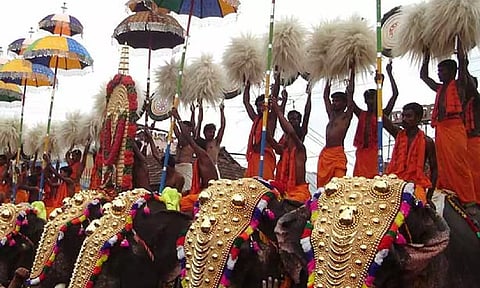

KERALA: In the backdrop of the recently concluded Thrissur Pooram, the largest temple festival in Kerala, the discourse around the use of caparisoned, captive elephants in the traditional festivities has once again occupied centre stage. The conversation assumes significance, especially when seen in the context of episodes involving the elephants turning on their human benefactors, at times with deadly consequences. Last month, a video of an elephant running amok and attacking another jumbo at the Tharakkal temple festival had gone viral on social media. The incident transpired when the elephant, Guruvayur Ravikrishnan, which was carrying the deity, got agitated and attacked another pachyderm, Puthupally Arjunan and chased the animal around the perimeter of the festive ground.
Fortunately, no loss of life was reported and the organisers managed to bring the elephants under control. However, the fact that such episodes of jumbos acting out against their captors have become almost emblematic of the festive season in Kerala demands that we reassess the role of such animals in traditional or religious rituals. Animal rights activists have been shouting from the rooftop for years regarding the inhumane treatment meted out to temple elephants across the region from being compelled to stand for hours together under the sweltering heat while being chained, to facing the trauma of deafening fireworks, blinding lights, and an unending swarm of devotees.
A few numbers might help contextualise this problem. Per the states Elephant Owners Federation, there are close to 7,400 temples in Kerala registered under the forest department that employ captive elephants for festivals and various religious rituals. The temple festival season usually commences in December and continues till mid-May. With as many as 430 captive elephants in Kerala, just about 300 are available for temple rituals, which tends to place a heavy load on the elephants, vis-a-vis being deployed at various venues. Its something that caught the attention of a Goa-based non-profit called the Centre for Research on Animal Rights.
Last year, the NGO petitioned Kerala Chief Minister Pinarayi Vijayan for an inquiry into the deaths of as many as 138 captive elephants in the state over a period of five years (25 in 2023 alone, and three have died in 2024). The group also urged the CM to enact legislation enabling the retirement of elephants over the age of 60, while suggesting the use of mechanical alternatives at poorams. Encouragingly, the NGO's perspectives havent been entirely ignored. Last year, a robotic elephant named Raman was gifted to the Irinjadappilly Sree Krishna Temple in Thrissur by People for Ethical Treatment of Animals (Peta) India, backed by actor Parvathy Thiruvothu.
More recently, in February, a robotic elephant was handed over to the Shivan Temple in Devarshola, Gudalur by an NGO called the Voices for Asian Elephants. Having said that, the purists believe that such artificial interventions will only end up diluting the essence of something as intrinsic to Kerala's identity as a temple festival. It might be doubly hard to convince them that there are virtually no references in our scriptures mandating that temple processions need to be carried out using elephants, a pricey affair in today's cash crunched times. India is home to 30,000 elephants, and a significant number of them turn casualties of man-animal conflict year after year. And the last thing we need is domesticating, chaining and abusing these animals on account of a sacred undertaking.